Man United are a pundit’s nightmare. Their performances this season can’t be summarised with a sweeping statement, as they go from week-to-week producing a range of performances. Occasionally it’s a fusion of pace and dynamism, showing signs of a revived side, good enough to stun the Etihad a week ago. On the other side, there’s a lethargic, uncreative personality to this group of players, a trait which has frustrated fans in this roller-coaster season for the North-West club.
For Colchester, the first-world problems of their opponents are a distant dream as they continue in their pursuit of a League Two play-off position. Three wins in the last five for the U’s has seen them move within three points of the final playoff spot.
With the season now leaving its infancy, maturing into middle-agedness, this fixture was a welcome break away from the domestic pursuits of both sides as they looked to progress to the semi-finals of the English League Cup.
In this tactical analysis, we look at how Man United set up tactically to break down a resilient Colchester side. We also provide an analysis of the tactics used by the visitors in their attempt to frustrate the Old Trafford faithful.
Lineups
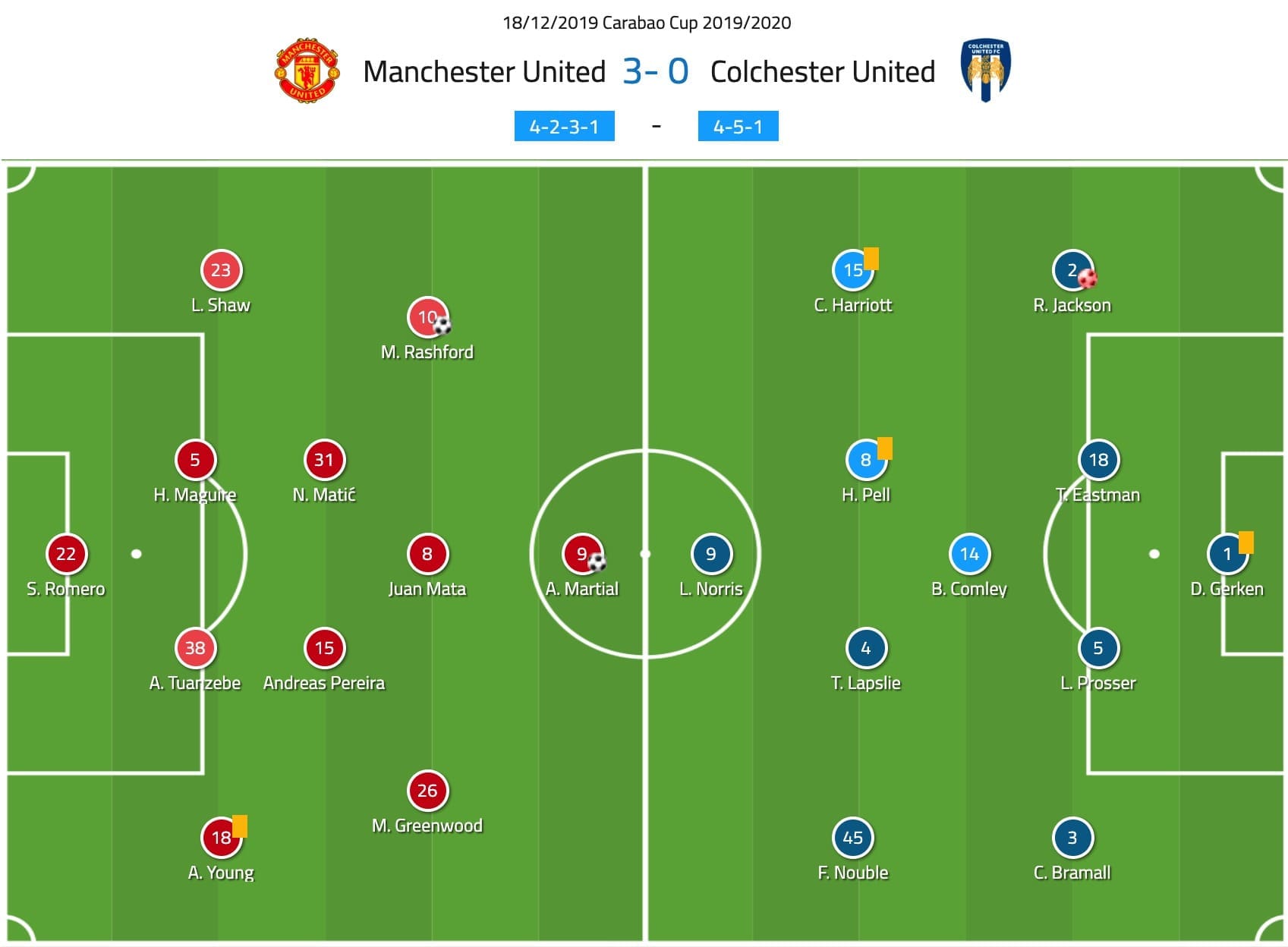
The hosts started in a familiar 4-2-3-1, with manager Ole Gunnar Solskjær demonstrating the importance he’s placing on this competition by fielding a strong first XI. There were a few alterations, however, reliable number two, Sergio Romero replaced David Ge Gea in goal. Juan Mata was the preferred option in the number 10 role. His ability to find spaces between the lines was useful as United attempted to break down their robust opponents.
Marcus Rashford and Mason Greenwood were deployed as inside forwards, the pair stayed narrow in the half-spaces to allow the full-backs to move forward and maintain the width of the team. Luke Shaw and Ashley Young were those full-backs. Their duty was to stay as wide as possible in an attempt to pull the defensive shape of their opponents laterally, giving the forwards opportunity to penetrate.
The visitors started the game in a 4-1-4-1 system, although this was rarely depicted on the pitch. From the first whistle Colchester sunk into a deep low block, looking to contain Man United by congesting the final third. This was particularly emphasised in the central zones as Colchester actively tried to block any passing lanes into the narrow front four of the opposition.
Dean Gerken started in goal, protected by the usual pairing of Tom Eastman and Luke Prosser. The pair kept their line deep, calling their full-backs to tuck in alongside them almost as additional centre-backs. This additional protection forced Man United to deliver more crosses which are easier to deal with. Frank Nouble and Callum Harriot were deployed as the wingers, their duties, however, reflected more of a wing-back role as we look at later. Top scorer Luke Norris led the line up-front, the Englishman had a tough night as his side struggled to keep the ball long enough to create any meaningful opportunities.
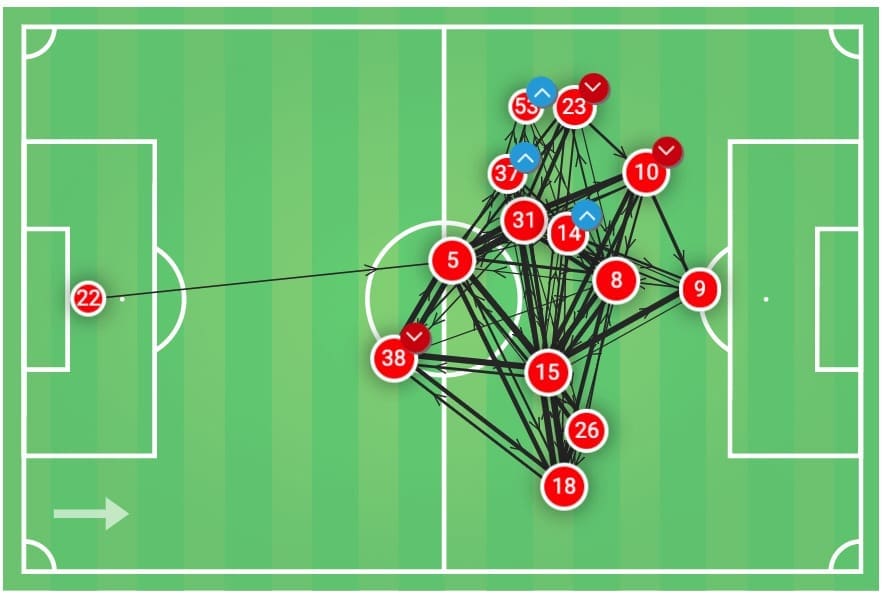
The game quickly adopted its tactical pattern; Man United held sustained periods of possession and camped themselves in the Colchester half, looking to work the ball through their structured shape. Colchester’s PPDA for the match was a massive 35, compared to Man United’s 7.39, showing their preference to contain the space over pressing the ball.
We can see above how advanced the United defenders positioned themselves, suffocating their opponents into eventual submission. With the full-backs playing on the same lateral line as the midfield, the double-pivot of Andreas Pereira and Nemanja Matić were stationed slightly ahead of their centre-back pairing, collecting the ball in the possession cycles and playing a range of short, sharp interchanges to long penetrative passes in behind. This mixture of passing from the double-pivot caused the visitors difficulties for the entire game, as we look at later.
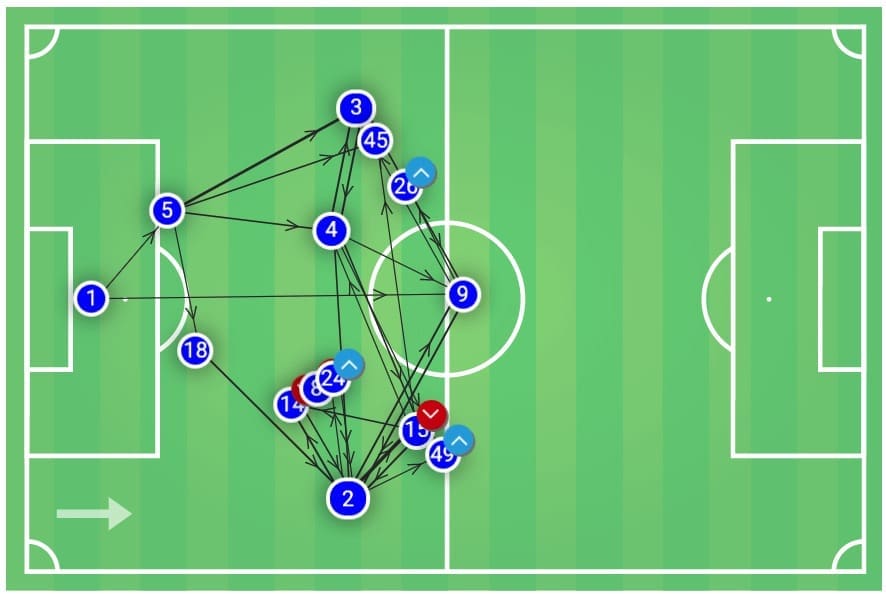
The Colchester pass map tells it’s own story. The visitors struggled to maintain any significant possession, achieving just 28% and a total xG of 0.25. Their passing was direct, often opting for a long pass early in possession over trying to pass through the Man United system. This is emphasised by their average passes per possession at 3.02 compared to Man United’s 7.95. Their attempts to be dangerous in transition were in futile however as the U’s managed zero successful counter-attacks that ended with a shot. The tactical reason for this is analysed below.
Lateral thinking
The decisive tactic used by Solskjær’s men was to stretch their opponents laterally. As we touched on above, this was achieved by the full-backs and inside forwards adopting separate passing lanes at varying vertical lengths. We can see above how Rashford (10) and Greenwood (26) played in the half-spaces rather than drifting wide. This allowed Man United to cause the defensive line a problem due to the multiple passes available on each passing occasion.
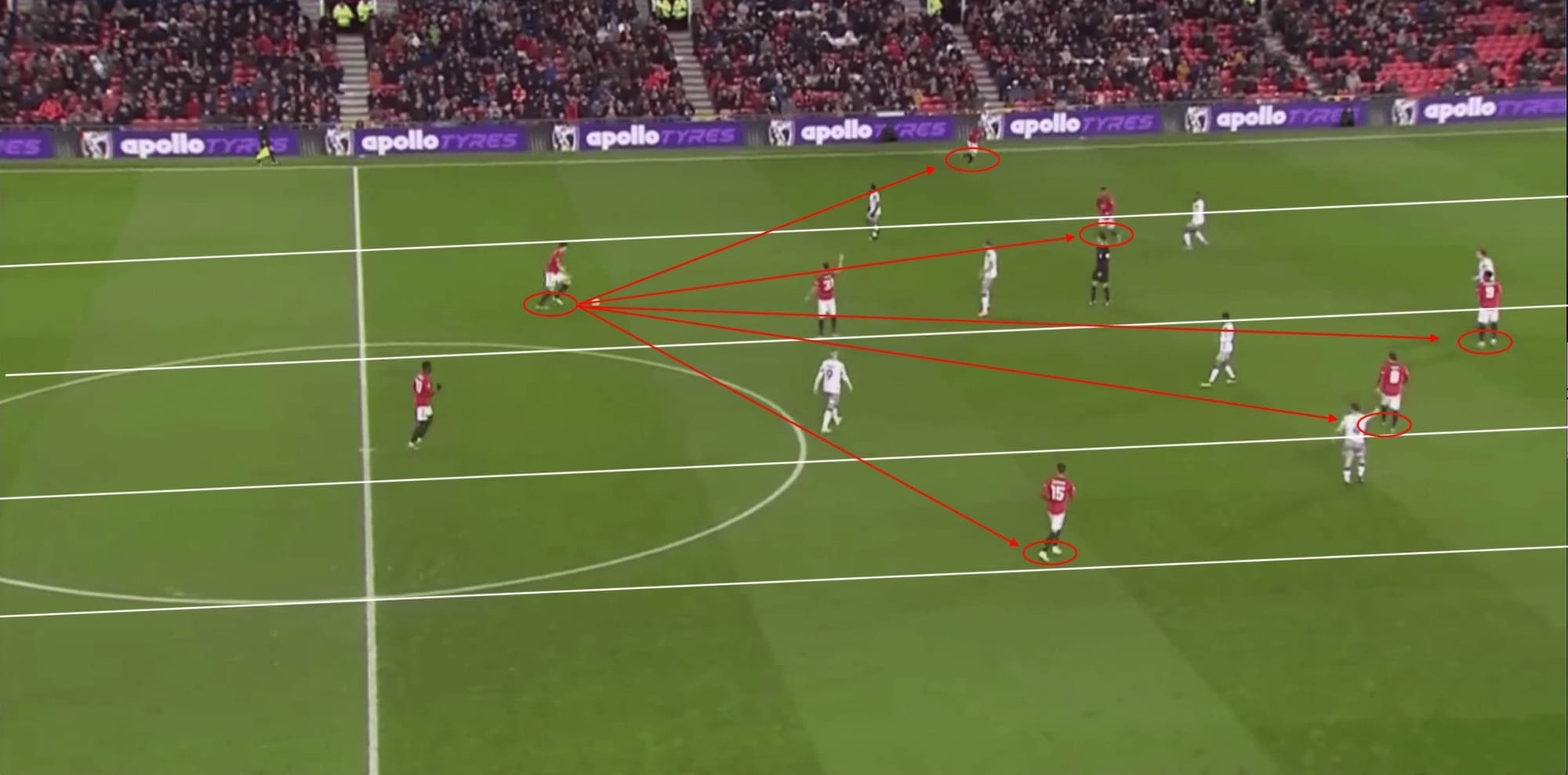
We can see above how Man United actively deployed their attacking unit in each zone of the large Old Trafford pitch. Anthony Martial remained central, keeping the centre-backs occupied. It was Rashford and Greenwood’s positioning which caused the tactical imbalance and forced Colchester to adjust. We can see above how Shaw has taken the wider space, pushing beyond his respective marker. Rashford in conjunction with this movement has dropped deeper to show for the ball. This puts the right-back, Ryan Jackson, in immediate danger of being overloaded. He has the dilemma of pressing Rashford to prevent him from turning if he receives the pass. Alternatively, he can contain his position to protect being penetrated by Shaw’s run. Neither option is the right answer.
This tactical battle ensued throughout the match. Colchester managed to maintain the fluid system of their opponents by adopting the shape below.
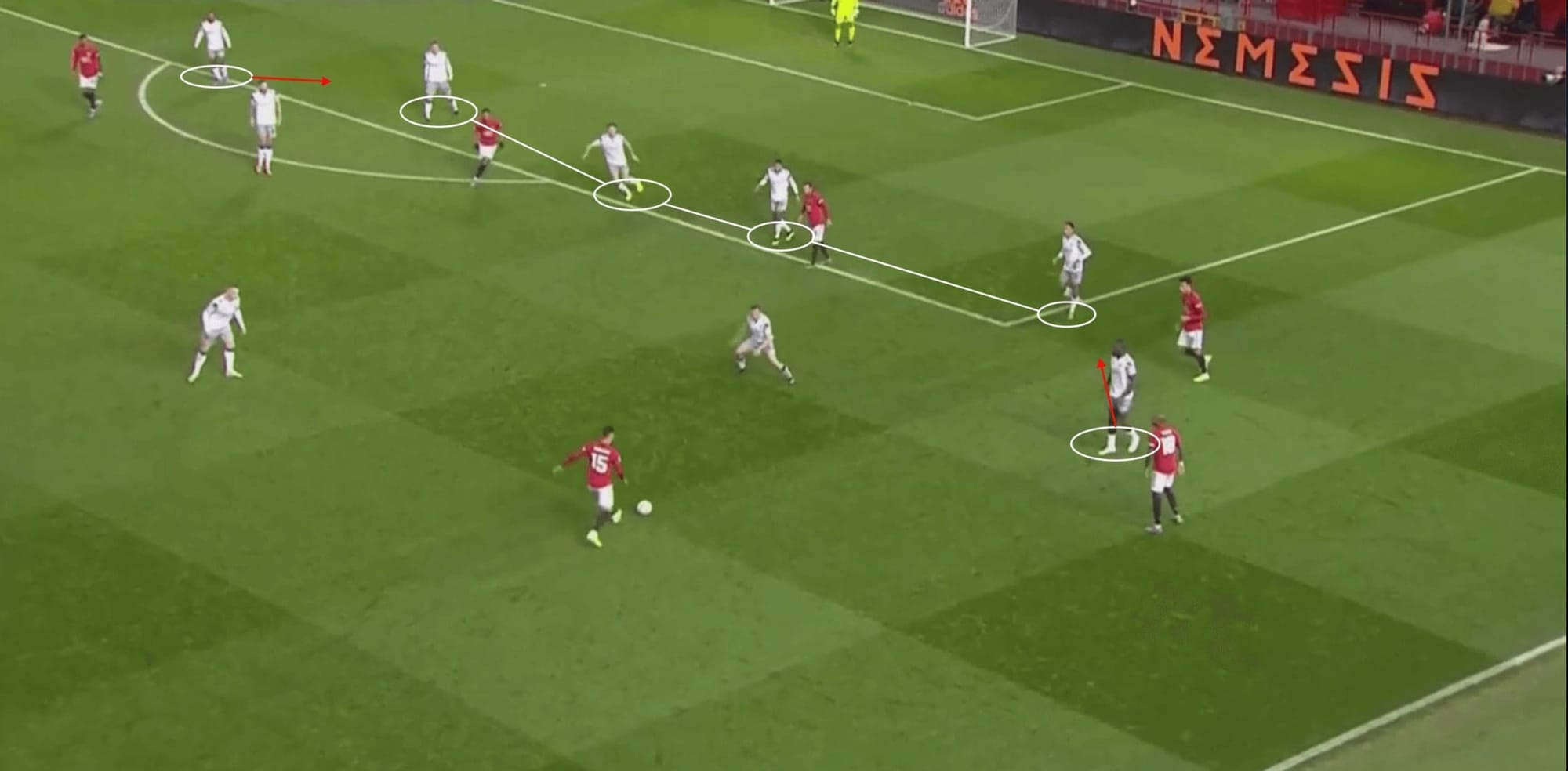
Harriot and Nouble were forced to retreat to prevent the overload. This allowed the full-backs of Colchester to protect the half-spaces which were being jarred open by the movements of Man United.
Though this stopped the home side from creating at will and restricted them from scoring until the second half, it nullified any threat Colchester could possess going forward. The League Two side carried very little threat in offensive transition due to their wingers being too heavily involved in the defensive structure. This left Norris isolated up front and allowed Man United to continuously attack the away side, pinning them in with wave after wave.
Once the first goal went in however, Colchester were forced to abandon this resilient set-up in search of getting a goal back themselves. This opened the flood gates for the Manchester club who could now create more easily with the additional space available in the half-spaces. Below we can see the stark and immediate contrast in defensive shape, as Colchester looked to be more adventurous but instead were punished ruthlessly.
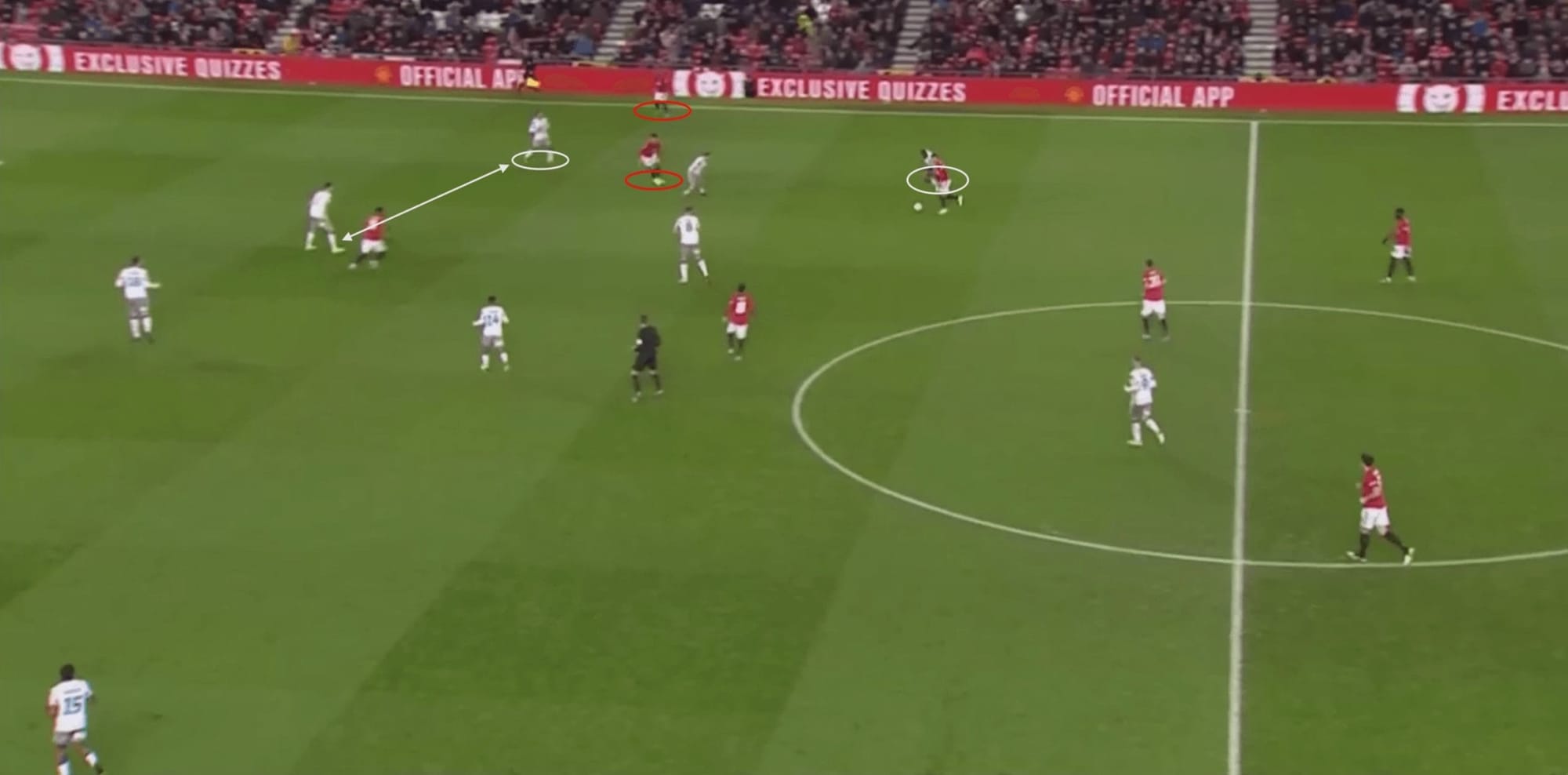
Above, a similar scenario in possession has developed, just after Man United scored their first goal. Notice how this time Nouble hasn’t tracked back into a wing-back position to help his full-back. The knock-on effect of this is great as it completely opens the half-space for Man United to penetrate through.
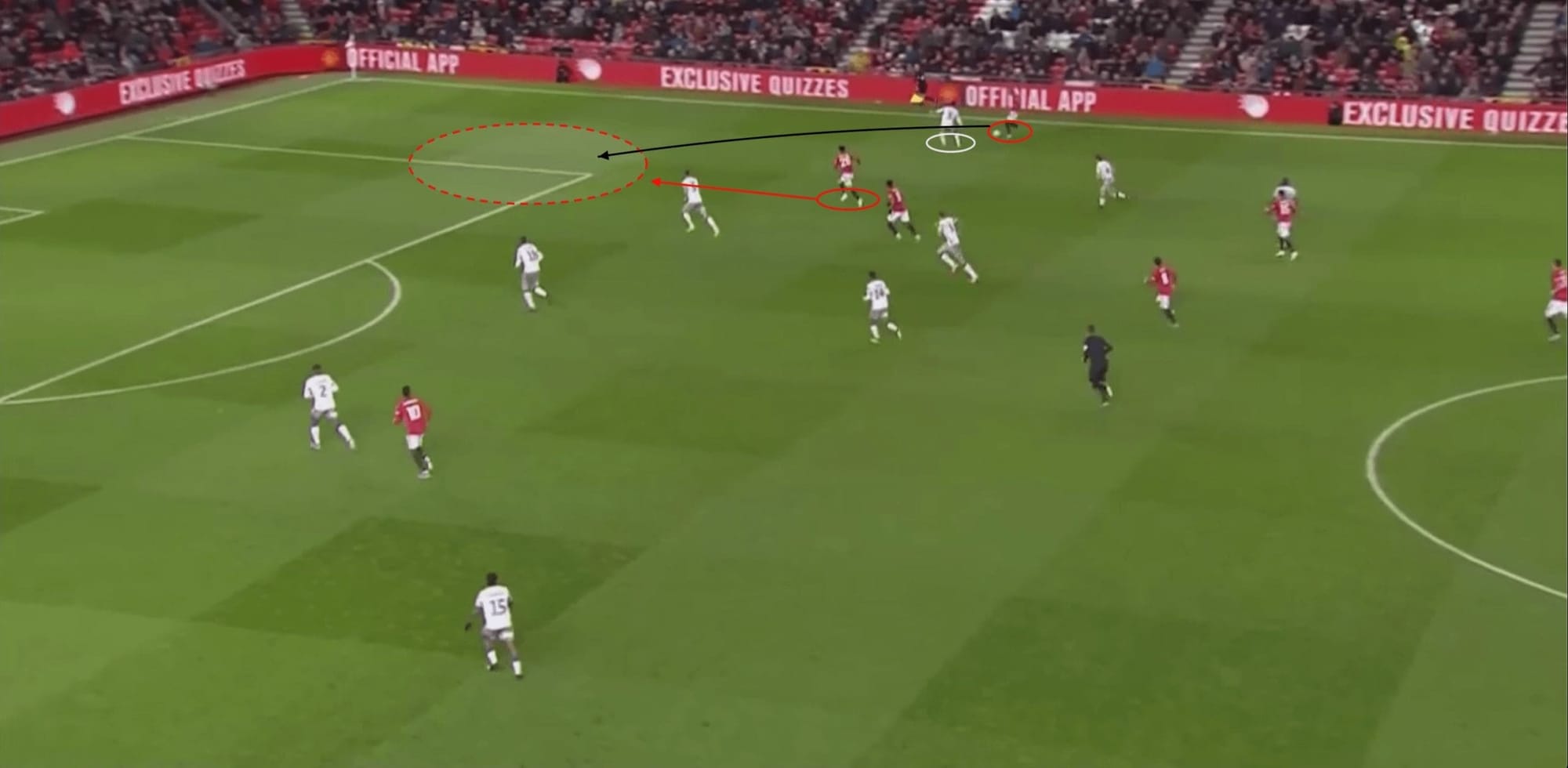
We can see above how Greenwood exploits the space by bursting through the Colchester back line. His movement pulls the centre-back across and out of position, in turn, disrupting the entire defensive shape. This was not happening in the first half when the half-spaces were blocked off. As a result, Greenwood gets a cross in which is put into the net by the full-back on the other side in an attempt to prevent a tap-in for Rashford.
Once the second went in, the third was inevitable as Man Untied picked off Colchester as they continued to advance further down the Old Trafford pitch.
Conclusion
In the end it was a formality for the home side, who with Liverpool out of the competition, will be looking at the League Cup as a realistic chance for silverware in an otherwise lacklustre season. The development signs of Solskjær’s young side continue to be visible on the pitch and the talent is certainly available, however, the key for this Man United team going forward is consistency from week to week.
Colchester can be proud of a solid first-half performance against a strong Man United outfit. Their tactical approach, though defensive, kept them in touching distance against a continued onslaught from their opponents. John McGreal will be hoping for similar defensive solidarity in their match against Carlisle on Saturday, a game where they’ll no doubt see more of the ball.

If you love tactical analysis, then you’ll love the digital magazines from totalfootballanalysis.com – a guaranteed 100+ pages of pure tactical analysis covering topics from the Premier League, Serie A, La Liga, Bundesliga and many, many more. Buy your copy of the December issue for just ₤4.99 here





Comments